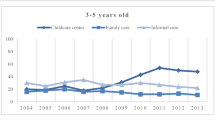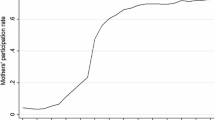Abstract
The market for childcare and the role of the government in the childcare market have grown enormously as mothers of young children have entered the labour force in very large numbers. Economists have made important contributions to understanding many aspects of childcare. This article focuses on (a) the effect of the price of childcare on labour force participation of mothers of young children, (b) the effect of childcare and early childhood interventions on children, and (c) the rationale for and effects of government involvement in childcare. Fruitful avenues of additional research are suggested.
Access provided by CONRICYT-eBooks. Download reference work entry PDF
Similar content being viewed by others
Keywords
- Adverse selection
- Child development
- Childcare
- Childcare subsidies
- Education production function
- Head start
- Human capital
- Imperfect information
- Labour force participation
- Market imperfections
- Moral hazard
- Poverty
- Random assignment
- Selfsufficiency
- Women
JEL Classifications
The market for childcare in advanced economies has grown enormously in response to the dramatic increase in labour force participation by mothers of young children. In 1950 12 per cent of married women in the United States with children under age six were in the labour force, compared to 63 per cent in 2000. Labour force participation of single mothers with children under six has also increased rapidly, reaching 65 per cent in 2000. As the market has grown, the role of the public sector in subsidizing, regulating, and providing childcare has increased substantially. One- third of all expenditure on childcare and preschool in the United States is financed by government subsidies or by direct provision of services. The public sector plays an even larger role in childcare in many European countries. Three aspects of childcare have received the most attention from economists: (a) the effect of the price of childcare on labour force participation of mothers, (b) the effect of childcare and early childhood interventions on child development, and (c) the rationale for and effects of government involvement in childcare. Childcare is interpreted broadly here to include care provided by someone other than a child’s parent either to facilitate employment of parents or to enhance child development.
Blau and Currie (2006) summarize the findings of 20 studies that estimate the elasticity of maternal labour force participation with respect to the price of childcare. The estimates vary widely across studies, but studies that account for the availability of informal unpaid childcare options usually estimate relatively small elasticities, in the range of − .09 to − .20. These studies use a multinomial choice framework that allows for the possibility that a mother can work without using paid childcare. Use of unpaid childcare by family members, relatives, and others is very common. The relatively small elasticity estimates suggest that a price increase induces substitution of informal unpaid childcare for paid care, dampening the sensitivity of maternal employment to the price of childcare. Some evidence suggests that the price elasticity is larger in absolute value for lower-wage women. This evidence confirms that childcare costs are a significant but not major barrier to employment of mothers. The evidence also implies that childcare subsidies increase work incentives of mothers, a finding confirmed by a small number of studies that directly analyse the impact of subsidy programmes on employment.
An important concern about childcare is that low-quality care could be harmful to the development of young children. Conversely, high-quality care may help compensate children from low-income families for the disadvantages of growing up in poverty. The effect of childcare on child development has traditionally been the domain of developmental psychology, but in recent years economists have contributed to this literature, noting its similarities to the ‘education production function’ literature for school-age children.
The quality of childcare can be characterized by ‘structural’ features such as the size of the group in which care is provided, the ratio of adult caregivers to children, and the education and specialized training of providers. Alternatively, direct observation of the developmental appropriateness of the care received by children can be made by trained observers using standardized instruments. These ‘process’ measures of quality are more proximate determinants of child development than are the structural features.
The small amount of evidence available suggests that higher-income parents do not choose higher-quality childcare on average: among users of day-care centres, there is no systematic relationship between family income and the quality of childcare used, if other factors are controlled for (Blau 2001). This is true whether the quality of care is measured by structural characteristics or process measures. This suggests that parents are either unable to discern the quality of care, or unwilling to pay the additional cost associated with higher-quality care, or both.
Several random assignment demonstration projects have evaluated the impact of high-quality preschool programmes for disadvantaged children (see reviews in Blau 2001; and Blau and Currie 2006). The results show that such programmes have delivered substantial long-run benefits to the participants and society: lower school dropout rates, higher earnings, fewer out-of-wedlock births, and lower public expenditures on welfare, criminal justice, and special education. Benefit-cost calculations show that these interventions have a very high social rate of return. This evidence is compelling, but it is based on very intensive and costly programmes that are of exceptionally high quality and are targeted at highly disadvantaged children. It is unclear whether childcare of moderately high quality provides positive but proportionately smaller developmental benefits, or whether there exists a threshold of quality below which benefits are negligible. It is also unclear how the quality of childcare affects children who are not highly disadvantaged. In non-experimental studies that follow children over time, higher-quality childcare is associated with better developmental outcomes in the short run (one to three years). However, it remains uncertain to what extent this is a causal impact. Recent studies that control for many other potentially confounding factors find that the quality-development association is smaller than in models with fewer controls, but remains significantly different from zero.
Two main arguments have been used to rationalize a role for government in the childcare market. The arguments are based on attaining economic self-sufficiency, and childcare market imperfections. On self-sufficiency, childcare subsidies might help low-income families achieve economic self-sufficiency, defined as being employed and not enrolled in welfare programmes. Self-sufficiency is a desirable goal because it may inculcate a work ethic and generate human capital through on- the-job training and experience. These arguments explain why many childcare subsidies require employment or work-related activities such as education and training. Subsidies for childcare and other work-related expenses paid to employed low-income parents may cost the government more today than would cash assistance. But these subsidies could result in increased future wages and hours worked and lower lifetime government support than the alternative of cash assistance both today and in the future. This argument has nothing to do with the effects of childcare on children, and there are few restrictions on the quality of childcare that can be purchased with employment-related childcare subsidies. However, evidence on wage growth of low-skill workers suggests that wages grow only modestly with experience, too slowly to lift low-skill workers out of poverty (Gladden and Taber 2000). Middle and upper-income families are generally not at risk of going on welfare, so it is not obvious that there is an economic rationale for subsidies for their employment-related childcare expenses.
As for market imperfections, the imperfections that are often cited are imperfect information available to parents about the quality of childcare, and positive external benefits to society generated by high-quality childcare (Walker 1991). Imperfect information exists because consumers do not know the identity of all potential suppliers, and the quality of care offered by any particular supplier is not fully known. A potential remedy for the first problem is government subsidies to resource and referral agencies to maintain comprehensive and accurate lists of suppliers. The second information problem arises because consumers know less about product quality than does the provider, and monitoring the provider is costly to the consumer. This can lead to moral hazard and/or adverse selection. The limited evidence available suggests that parents are not well-informed about the quality of care in the arrangements used by their children. Childcare subsidies targeted at high-quality providers could induce parents to use higher-quality care.
The externality argument is a standard one that closely parallels the reasoning applied to education. High-quality childcare leads to improved intellectual and social development, which in turn increases school readiness and completion. This reduces the cost to society of problems associated with low education: low earnings, unstable employment, crime, drugs, teenage childbearing, and so forth. If parents are not fully aware of these benefits, or account for only the private and not the social benefits, then they may choose childcare of less than socially optimal quality. This argument could rationalize subsidies targeted to high-quality providers, such as Head Start, a US programme aimed at enhancing cognitive and social development of low-income children.
As this discussion implies, childcare policy can be used to facilitate employment of mothers and enhance development of young children. There is likely to be a trade-off between these goals because higher-quality care is more expensive. There is not a political agreement in the United States to spend enough to achieve both goals, or on which goal should have the highest priority. This is due in part to conflicting views on the proper role of the government in a domain that was mainly left to families until the last quarter of the twentieth century. But it also reflects lack of knowledge about the magnitudes of important parameters that affect the costs and benefits of alternative policies. Economists could make significant contributions to knowledge by careful empirical studies that produce reliable estimates of such parameters. The following issues seem important and well-suited to analysis by economists. Despite a large number of studies, there is considerable uncertainty about the magnitude of the elasticity of maternal employment with respect to the price of childcare. A careful sensitivity analysis could help resolve this uncertainty. Research on the price-responsiveness of low-income mothers would be especially useful. Consumer demand for quality in childcare is not well-understood, and new research could be valuable. Research on the take-up decisions of families eligible for childcare subsidies would be useful in order to determine the likely effectiveness of different forms of subsidies. New research on the supply of childcare would be useful. Subsidies to consumers may bid up the price of childcare, and it is important to be able to quantify such effects. It would also be useful to examine the quality supply decisions of providers, in order to determine how responsive the supply of high-quality care might be to subsidies.
Bibliography
Blau, D. 2001. The child care problem: An economic analysis. New York: Russell Sage Foundation.
Blau, D., and J. Currie. 2006. Preschool, day care, and after school care: Who’s minding the kids? In Handbook on the economics of education, ed. E. Hanushek and F. Welch. Amsterdam: North-Holland.
Gladden, T., and C. Taber. 2000. Wage progression among less skilled workers. In Finding jobs: Work and welfare reform, ed. R. Blank and D. Card. New York: Russell Sage Foundation.
Walker, J. 1991. Public policy and the supply of child care services. In The economics of child care, ed. D. Blau. New York: Russell Sage Foundation.
Author information
Authors and Affiliations
Editor information
Copyright information
© 2018 Macmillan Publishers Ltd.
About this entry
Cite this entry
Blau, D.M. (2018). Childcare. In: The New Palgrave Dictionary of Economics. Palgrave Macmillan, London. https://doi.org/10.1057/978-1-349-95189-5_1977
Download citation
DOI: https://doi.org/10.1057/978-1-349-95189-5_1977
Published:
Publisher Name: Palgrave Macmillan, London
Print ISBN: 978-1-349-95188-8
Online ISBN: 978-1-349-95189-5
eBook Packages: Economics and FinanceReference Module Humanities and Social SciencesReference Module Business, Economics and Social Sciences




